
The Soviet–Afghan War was a protracted armed conflict fought in the Soviet-controlled Democratic Republic of Afghanistan (DRA) from 1979 to 1989. The war was a major conflict of the Cold War as it saw extensive fighting between Soviet Union, the DRA and allied paramilitary groups against the Afghan mujahideen and their allied foreign fighters. While the mujahideen were backed by various countries and organizations, the majority of their support came from Pakistan, the United States, the United Kingdom, China, Iran, and the Arab states of the Persian Gulf. The involvement of the foreign powers made the war a proxy war between the United States and the Soviet Union. Combat took place throughout the 1980s, mostly in the Afghan countryside. The war resulted in the deaths of approximately 3,000,000 Afghans, while millions more fled from the country as refugees; most externally displaced Afghans sought refuge in Pakistan and in Iran. Approximately 6.5% to 11.5% of Afghanistan's erstwhile population of 13.5 million people is estimated to have been killed over the course of the conflict. The Soviet–Afghan War caused grave destruction throughout Afghanistan and has also been cited by scholars as a significant factor that contributed to the dissolution of the Soviet Union, formally ending the Cold War. It is also commonly referred to as "the Soviet Union's Vietnam".
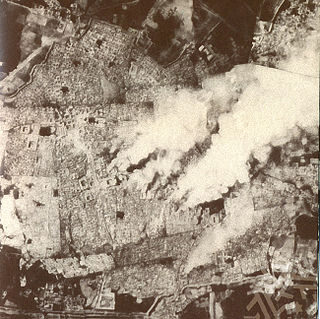
The Basmachi movement was an uprising against Imperial Russian and Soviet rule in Central Asia by rebel groups inspired by Islamic beliefs.

The Polish–Lithuanian War was an undeclared war fought in the aftermath of World War I between newly independent Lithuania and Poland, with fighting mainly in the Vilnius and Suwałki regions, which was part of the Lithuanian Wars of Independence and lasted from May 1919 to 29 November 1920. Since the spring of 1920, the conflict happened alongside the wider Polish–Soviet War and was affected by its progress. It was subject to unsuccesful international mediation at the Conference of Ambassadors and the League of Nations.

The Allied intervention in the Russian Civil War consisted of a series of multi-national military expeditions that began in 1918. The initial impetus behind the interventions was to secure munitions and supply depots from falling into the German Empire's hands, particularly after the Bolsheviks signed the Treaty of Brest-Litovsk, and to rescue the Allied forces that had become trapped within Russia after the 1917 October Revolution. After the Armistice of 11 November 1918, the Allied plan changed to helping the White forces in the Russian Civil War. After the Whites collapsed, the Allies withdrew their forces from Russia by 1925.

Relations between the Soviet Unionand Japan between the Communist takeover in 1917 and the collapse of Communism in 1991 tended to be hostile. Japan had sent troops to counter the Bolshevik presence in Russia's Far East during the Russian Civil War, and both countries had been in opposite camps during World War II and the Cold War. In addition, territorial conflicts over the Kuril Islands and South Sakhalin were a constant source of tension. These, with a number of smaller conflicts, prevented both countries from signing a peace treaty after World War II, and even today matters remain unresolved.
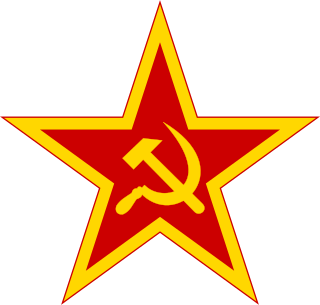
The Soviet Armed Forces, also known as the Armed Forces of the Soviet Union, the Red Army (1918–1946) and the Soviet Army (1946–1991), were the armed forces of the Russian SFSR (1917–1922) and the Soviet Union (1922–1991) from their beginnings in the Russian Civil War of 1917–1923 to the collapse of the USSR in 1991. In May 1992, Russian President Boris Yeltsin issued decrees forming the Russian Armed Forces, which subsumed much of the Soviet Armed Forces. Multiple sections of the former Soviet Armed Forces in the other, smaller Soviet republics gradually came under those republics' control.

The Sino-Soviet conflict of 1929 was an armed conflict between the Soviet Union and the Chinese warlord Zhang Xueliang of the Republic of China over the Chinese Eastern Railway.

The Armenian-Azerbaijani war (1918–1920) was a conflict that took place in the South Caucasus in regions with a mixed Armenian-Azerbaijani population, broadly encompassing what are now modern-day Azerbaijan and Armenia. It began during the final months of World War I and ended with the establishment of Soviet rule.
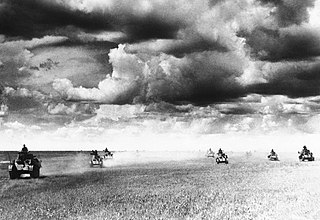
The Soviet–Japanese border conflicts, also known as the Soviet-Japanese Border War, the First Soviet-Japanese War, the Russo-Mongolian-Japanese Border Wars or the Soviet-Mongolian-Japanese Border Wars, were a series of minor and major conflicts fought between the Soviet Union, Mongolia and Japan in Northeast Asia from 1932 to 1939.

The partition of the Ottoman Empire was a geopolitical event that occurred after World War I and the occupation of Constantinople by British, French, and Italian troops in November 1918. The partitioning was planned in several agreements made by the Allied Powers early in the course of World War I, notably the Sykes–Picot Agreement, after the Ottoman Empire had joined Germany to form the Ottoman–German alliance. The huge conglomeration of territories and peoples that formerly comprised the Ottoman Empire was divided into several new states. The Ottoman Empire had been the leading Islamic state in geopolitical, cultural, and ideological terms. The partitioning of the Ottoman Empire after the war led to the domination of the Middle East by Western powers such as Britain and France, and saw the creation of the modern Arab world and the Republic of Turkey. Resistance to the influence of these powers came from the Turkish National Movement but did not become widespread in the other post-Ottoman states until the period of rapid decolonization after World War II.
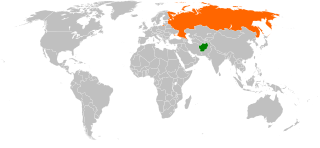
Relations between Afghanistan and Russia first emerged in the 19th century. At the time they were placed in the context of "The Great Game", Russian–British confrontations over Afghanistan from 1840 to 1907. The Soviet Union was the first country to establish diplomatic relations with Afghanistan following the Third Anglo-Afghan War in 1919. On 28 February 1921, Afghanistan and the Soviet Russia signed a Friendship Treaty. The Soviet Union intervened in Afghanistan against the Basmachi movement in 1929 and 1930.
Urta Tagay is an island in the middle of the river Panj on the border of Afghanistan and Tajikistan in Central Asia. It lies between the towns Farkhor and Yangi Qala. It is administered by Takhar Province, Afghanistan. It was the subject of two border conflicts: one in 1913 and another in 1925.

The Bukharan People's Soviet Republic was a Soviet state that governed the former Emirate of Bukhara during the years immediately following the Russian Revolution. In 1924, its name was changed to the Bukharan Socialist Soviet Republic. After the redrawing of regional borders, its territory was assigned mostly to the Uzbek SSR and some to the Turkmen SSR.
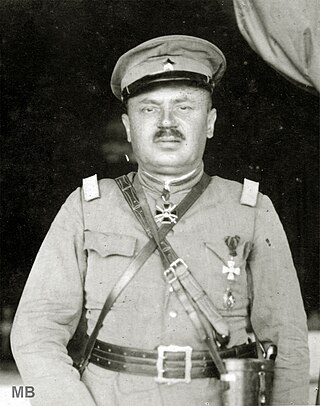
Konstantin Petrovich Nechaev was an Imperial Russian Army officer and White movement leader, who commanded a large Russian mercenary army in China from 1924 to 1929. Fighting for the Fengtian clique warlords Zhang Zuolin and Zhang Zongchang, Nechaev took part in several wars of the Chinese Warlord Era until his mercenary force was destroyed in the Northern Expedition. Thereafter, he mostly retired from military service and became a White émigré community leader in Manchuria. Captured by SMERSH during the Soviet invasion of Manchuria, Nechaev was executed by Soviet authorities in 1946.
The Bukharan Revolution refers to the events of 1917–1925, which led to the elimination of the Emirate of Bukhara in 1920, the formation of the Bukharan People's Soviet Republic, the intervention of the Red Army, the mass armed resistance of the population and its suppression, the inclusion of the republic into the Soviet Union on 27 October 1924, as a separate union republic, the elimination of the newly established republic as a result of national delimitation and the formation of the Uzbek SSR, the Turkmen SSR and Tajik ASSR in 1924.
The Urtatagai conflict was a conflict between the Emirate of Afghanistan and the Russian Empire over control of the island of Urta Tagay, which took place 1913. It began in November, when Afghan troops were deployed on Urtatagai after it had merged with the Afghan bank, placing it within Afghan territory. Sometime later, the flow of the river once again separated the island, and on an agreement on 13 December at Ashgabat, the Afghan leadership agreed to return the island, ending the conflict.
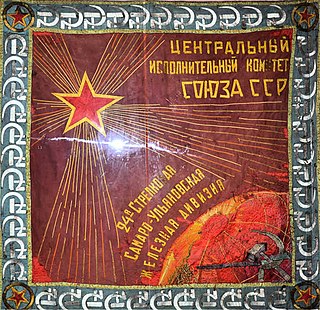
The 68th Mountain Rifle Division was a mountain infantry division of the Red Army before and during World War II.

The Emirate of Afghanistan was an unrecognized state in Central Asia ruled by the Saqqawists that existed from January to October 1929. Habibullāh Kalakāni became the state's only emir on 18 January 1929. After the fall of Kalakāni on 13 October 1929, the Emirate ended.
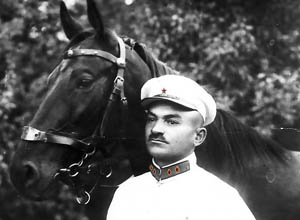
Yakov Arkadievich Melkumov was a Soviet military commander of Armenian origin. He fought in the First World War and the Russian Civil War. He particularly distinguished himself during the Russian Civil War fighting against the Basmachi movement on the Turkestan Front. He is known for commanding the unit that killed the former Ottoman general who had commanded the Basmachi rebels, Enver Pasha, who was one of the main architects of the Armenian genocide.
Shir Muhammad-bek Gazi, also known as Mahmud-Bek also known under the nickname Korshirmat was a prominent figure of the Basmachi Movement in exile since 1923, the first head of the Turkestan Union during the Great Patriotic War with the support of the Abwehr to restore the insurrectionary movement in Turkestan.















